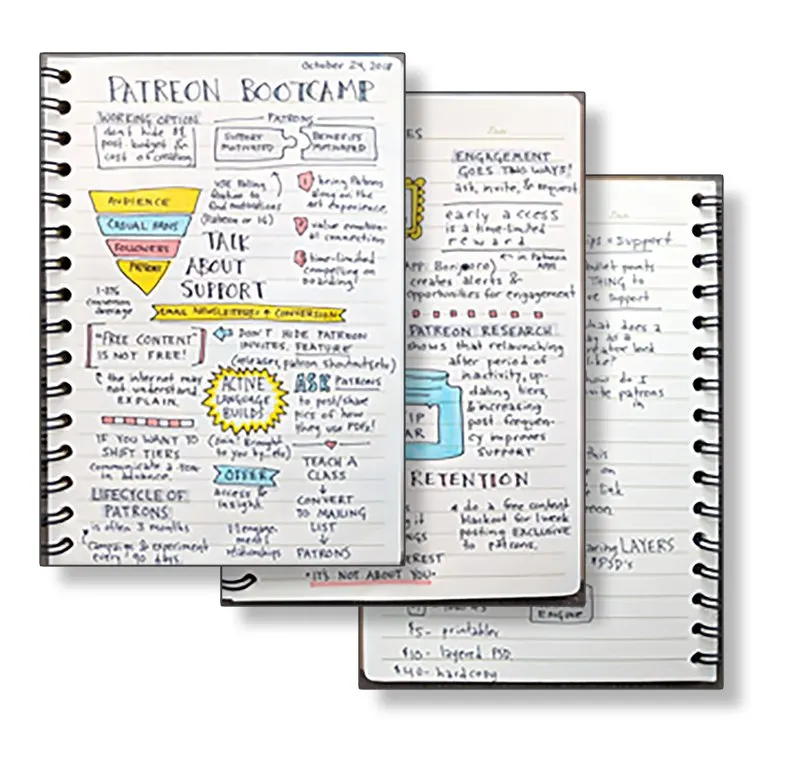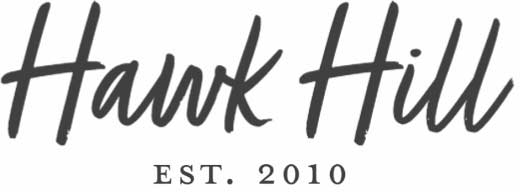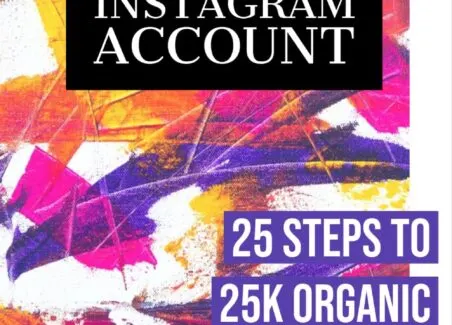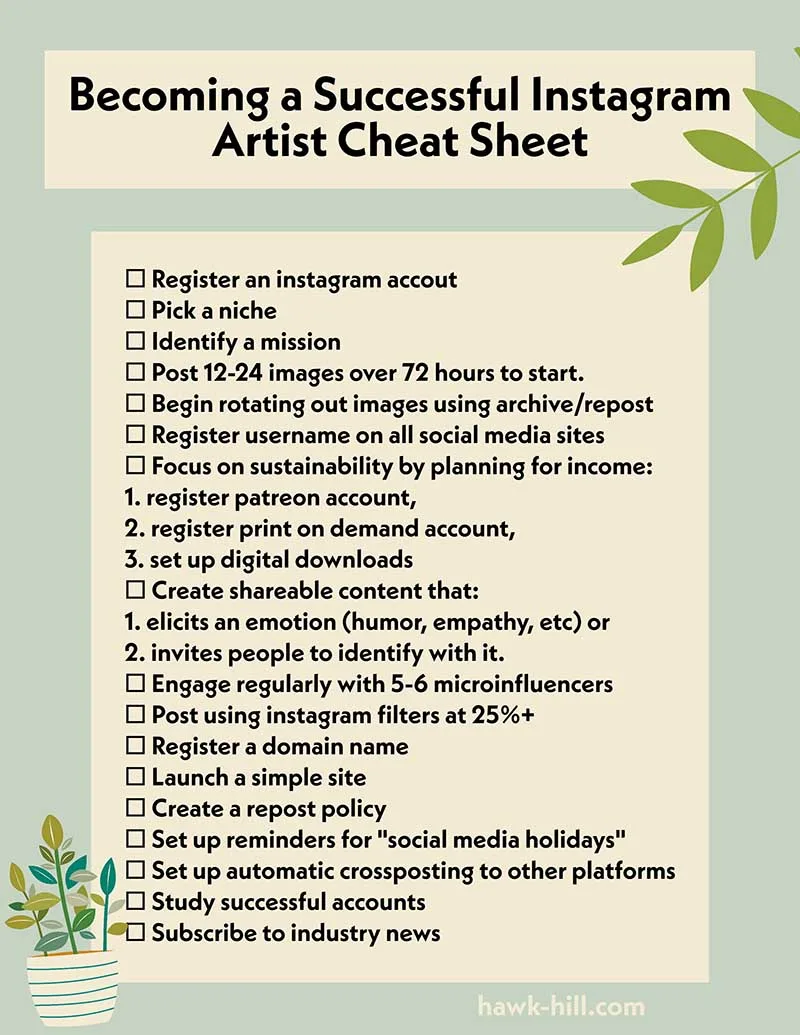When I started website-building in the pre-blog era of 2005, I found an article titled “26 steps to $26k in One Year.” Although by 2024 standards that advice would be terribly outdated, those 26 steps were my gameplan and helped me create several thriving websites and, eventually, Instagram art accounts.
Although for the sake of privacy I won’t be sharing the username in this post, my most successful social media presence is on Instagram, where I recently passed 130,000 followers on my art instagram.
As a way to “pay forward” the help I got through that guide to starting an online business, I decided to collate the knowledge I’ve gained. Through growing my Instagram account and staying up to date on multiple social media marketing channels into my own document, I’ve learned many skills that I’m sharing today in my informally titled Guide to 25 steps to 25k followers on an art instagram in one year.

How to succeed as an artist on Instagram in 2022:
1. Just start
It’s harder than ever to get started on Instagram – or any platform, but waiting won’t make it any easier. The first step to succeed on Instagram in 2024 as an artist is simple: start.
Even if you feel like you don’t have much of a portfolio, an established style, or if weaknesses in your technique seem obvious to you, start now. Starting is the hardest part, but once you’ve started you can grow momentum that both grows your account and grow your artistic skill through practice.
Don’t wait to be great, start where you are at with what you’ve got: let your consistent posting begging to grow a following and let that following encourage you to grow your skill through practice.
2. Find what you do uniquely, and pursue doing that thing well.
I once heard the highly successful abstract artist Makato Fujimura speak to a group of aspiring creators. In that talk, he spoke at length about how in art school he realized very early that he was not the most talented artist in his class, so what he set out to do was to discover what he did uniquely and pursue as much growth as possible within that particularly. I heard this story as I was starting my art account and it was formational to how I think about my work (and handle the ever-present internal critic who says I’m not the best, or even particularly good).
3. Post Often and Archive, Repost, Archive, Repost, Repeat
For the first month or two after starting your new art account, post 1-2 times a day. Every time your follower count doubles, archive half your content and start reposting it again, 1-2 posts a day. This saves effort, still delivers new content to most followers, and results in faster growth.
The Instagram algorithm favors consistent, frequent posts. For many influencers, this isn’t a challenge, but for artists who put a lot of time into their posts, it can be exceptionally difficult to keep up with new content consistently. Since most followers won’t see any given image the first time you post it, and since your account will be growing rapidly, set up a schedule by which you archive older posts randomly, and repost them regularly. This allows you to keep posting content that is new to most viewers without exhausting yourself trying to consistently create brand-new content.
You can archive old posts in batches, but don’t delete posts. Anecdotal reports say dumping the contents of an entire account can reactivate some of the new-user limits.
4. Set a posting pattern that supports your sustainability
Unless you’re a prolific professional artist, you probably won’t be able to create new art every day, long term. In order to maintain posting consistency, set a posting schedule that alternates between new content, works in progress, and repost.
Consistency really does make a difference. I’ve settled on an every other day routine, but I only post new content 1.3 times a week. How? By following this schedule:
- day 1: repost something old (archive the original)
- day 3: post new content,
- day 5: post low hanging fruit (for my art account, that’s WIPs or pics of prints/stickers/etc)
- day 7: repeat cycle.
Download a PDF Checklist of Instagram Art Marketing Essentials:
5. Pick a niche
If your art account is like 1 million other art accounts, you can expect to blend in with the crowd and to have difficulty developing your account. A vague niche, for example, anime commissions or acrylic pour paintings, you’ll have a little more traction as you try to develop your account. But my advice is to take a step further, do something different with what you’re doing. Perhaps your anime art becomes a Disney-anime mashup account, perhaps your acrylic flows become a specialty in embedding semiprecious stones in your art or some other unique, signature element.
6. Identify a cause mission
This is my number one advice to new creators on any platform: identify a mission.
I’m convinced that mission-based art accounts grow exponentially faster than general art accounts or even niche accounts.
What do I mean by mission-based? It means your account is “about” something. Advocacy for increased access to early childhood education, political causes, disability rights, LGBTQIA issues, etc, etc, etc- if you care about it, there are others who want to connect with you and amplify your voice. If at least some of your posts center around a cause you care deeply about, people who are passionate about that cause are more likely to follow (and more likely to find a reason to share your content).
When you use your Instagram as a platform for cause, you allow your visitors and followers to identify with you – and people are far more likely to engage, follow, and promote accounts that they identify with.
Not only does having a meaningful purpose encourage following and sharing, but it can be converted to sales. A mission + quality product = loyal customers. Whether it’s female empowerment, size-inclusive, gender-inclusive, niche (burlesque, vintage designs, drag, etc), customers who care about their purchase are willing to pay a premium price (or follow you over to Patreon as monthly supporters).
The following section may contain affiliate links. As an Amazon Associate, we earn from qualifying purchases.
7. Create shareable content
The more sharable the content, the better. But not all content “shares well.”
In my experience, the posts that get shared the most are posts that 1. elicit an emotion or 2. that people identify with and want to share in order to communicate something about who they are and what is important to them. These shareable posts are succinct and clear, usually including text.
In the 2013 book “Contagious: Why Things Catch On,” author Jonah Berger concluded that strong emotions motivate viewers to share content. He says, “Anger and anxiety lead people to share because, like awe, they are high-arousal emotions. They kindle the fire, activate people, and drive them to take action.”
8. Repost from other artists – with accurate credit – in your stories.
At least several times a week, choose three pieces of art you like from accounts with 10K – 30 K followers and share them to your stories. Be sure and manually add text that tags their username (this is emerging as the “correct” way to attribute art posts that are shared to stories.)
Why share? This strategy is about relationship building. When you share someone’s post they receive a message. About 5 to 10% of the time, you’ll get a reply with a quick thank you or emoji. When you get that response, write a brief, authentic message about what you like about their art. After you’ve exchanged two or three messages, you’ve got the start of a relationship that may lead to a micro-influencer following you, and helped the algorithm begin to understand that you and that user are somehow connected.
Through relationship building with micro-influencers, you’re building personal connections that can result in that user sharing your work in their feed.
9. Focus on relationships
There is no substitute for genuine engagement. Pick a few accounts that are 4 to 5 times larger than your account, and become more than a casual follower. Watch and reply to their stories and engage authentically (no spammy responses!) with genuine reactions to their art and story content.
Again, you’re focusing on creating organic engagement that flows both ways through the algorithm, linking you to bigger accounts with a larger reach.
10. Unfollow all celebrities
I don’t actually know if this helps grow an Instagram account, but it will reduce by 99% all direct messages with advertising, spyware, and malicious links.
11. Always use filters
I don’t know why using Instagram’s filters matters, but in experiments on my own account, posts that use a filter generally have a greater reach and are more likely to be featured on “explore.” The results seem to diminish if the filters are used at less than 25% strength, so tweak your colors before uploading, as needed, to produce the desired final image.
12. Own your Own Content and Diversify
From day 1, think beyond Instagram and TikTok. If your creative business is only on social platforms, you are completely at the mercy of shifting Instagram policy and TikTok trends.
To gain independence from these corporate-controlled platforms, mirror your content by starting a website (It’s really easy to start). A simple WordPress site with the Instagrate Plugin can automatically create posts for each photo and caption already on your Instagram.
Although it can take months or years for websites to gain traction, many visual artists earn a comfortable living through display advertising on their site. Ready to sign up for display ads on your site? Check out the links below:
Please consider using my referral link for Ezoic or my referral link for Monumetric– affiliate income helps keep this guide online for other creators.
13. Learn to be a bulldog about copyright.
Let’s be clear: if you are an artist on Instagram your art will eventually be stolen. Here’s how you can fight back:
If you are the artist, you can comment and ask for them to credit you in the way you want to be credited (like: “top line, tagged in the image, etc”) and if they do not comply, you are within your rights to file a copyright claim against the account. One easy way to communicate this policy to potential repost-ers is to make “repost policy” a highlight on your account.
When your art is stolen:
IG takes copyright claims very seriously, and all of the copyright claims I’ve had to file have resulted in an image removed within 24 hours.
This shouldn’t be a first resort though, having an image removed can have huge penalties for the offending account, so be respectful, ask first, and file a claim only as a last resort or for blatant violators.
Filing a copyright infringement claim will also require that you provide them your personal data (name, address, phone number) so if you are an artist on IG it’s a good idea to figure out in advance safe ways to provide that data accurately (like using a PO box- or “general delivery”- for the address, a google voice number for phone number, etc).
14. Picking a username
Look, we all know the good usernames are taken, but there are still some nonnegotiable’s for a good username:
- Easily brandable.
- easy to remember.
- easy to spell.
- Easy to spell just by hearing it
That means no dashes, no dots, no weird spelling. Say the username out loud to a friend and if they can’t spell it back to you, pick a new username.
15. Beware of scams, cheats, engagement groups etc
Since automation bots were harshly limited in the summer of 2019, there is no way to hack your way to quality followers. Avoid engagement groups or comment spamming, as the current algorithm does recognize and penalize these actions.
16. Stay Relevant
With the amount of world-shaking global news occurring seemingly so regularly recently, it’s more important than ever to pay attention and post relevant, appropriate content. That means avoiding particularly irreverent content during the first days of sobering global crises (aka coronavirus pandemic) but it also means keeping up with what are known as “social media holidays” you know- like #nationalicecreamday or #hugyourbrotherday
even if you think these “hashtag holidays” are silly, if you have relevant content and post using trending hashtags you may find a boost in your followers from participating in this playful pastime.
17. Limit your use of hashtags
Gone are the days of 30 hashtags per post. While it’s still the “limit” you are allowed, social media researchers have determined that a lower number of hashtags – like 6 to 8 – actually tend to result in a post with farther reach.
18. Avoid the most popular hashtags
Look, #BossBabe might have 15 million posts, but that same popularity is what will absolutely bury your post instantly. Instead of using the most popular hashtags, focus on niche hashtags (where your post will have more traction for longer ) or trending hashtags (where your post will have less traction but more eyes on it).
19. Always be creating
If you create art consistently, you will find that brainstorm-like inspiration will hit you randomly. Whether it is in the shower (dry off first), driving down the road (please pull over), or just sitting at your desk, write it down! If you wait five minutes, you may forget all about that great idea. Write it down, doodle it, make notes, and get specific- I can’t tell you how many rough sketches I have in my notebook that I have no idea what I was actually trying to communicate at the time
20. Own your links
Don’t send followers to linktree when you could funnel them directly to a link-page on your own domain. Don’t invite people to patreon.com/you when you could set up a redirect from you.com/patreon.
Early on, set up custom redirects or short URLs on your domain that YOU can control.
Why? As a backup plan. Here’s the thing: as you continue on your art journey you’ll spend the next months and years months and years dropping your Patreon link attached to every release. But what if Patreon disappears? Or becomes synonymous with a type of content you don’t want to be associated with? or kicks you off, raises their fees, has a better competitor come along, etc, etc, etc? Don’t get stuck with thousands of links in dm’s, posts, etc that send potential patrons into the abyss of the internet (or a defunct patreon creator page).
Instead, send people to your patreon page by way of a simple 301 redirect from yourdomain.com/patreon, if and when you move on from Patreon, all those leads can be redirected to your new home.
Most website hosts control panels make this easy, but send a message to your host’s support if you need help.
Similarly, never link an external domain (etsy, amazon, society6, etc) in your captions, stories, or profile. Instead, set up custom links.
21. Always crosspost.
Make sure you are on all the major social networks and interlink them. As soon as possible, register your Instagram account’s username on the top 10 social networks. Be sure to register on popular sites that you personally don’t ever use- this ensures that if people cross-post your art on that platform, there is an account there that they can tag. Use Instagram’s options to cross-post- even if you hate Tumblr or don’t have a clue about twitter- creating an audience on that platform is as easy as keeping that box checked.
22. Study Successful Accounts
Find other accounts in your genre and study what they are doing. Without copying, model your account on your practices after these thriving accounts.
23. Stay up to Date on Industry News
This is a big one: Follow news feeds, reddit subs, and podcasts about marketing, blogging, and social media management. Even just making sure that your newsfeeds include headlines from media and marketing feeds can help you keep abreast of the important information you need to know.
I call this passive learning: bits of valuable information that pop up in the otherwise-mostly-fun feed I curate on my social media accounts.
24. Monetize Your Content ASAP
Even if you started your art account just to share your art and connect with other fans, as your account grows you will have opportunities to make money off of your account. Starting the process early can prevent a lot of hard work trying to catch up later.
For artists, it’s never too early to start a Patreon account. I’m going to say that again because it’s that important: it’s NEVER TOO EARLY to start a Patreon.
You may think you need to “get better” or grow a following before starting your Patreon, there, but there are thousands of Patrons out there who are thrilled to support small/unknown/starting-out creators.
If you are ready to take the leap to start a Patreon, consider joining using this referral link, which gives me a small bonus if your first month goes well and helps keep this guide online.
PRO TIP: Reframe your perspective and work on the assumption that you will be successful in 18-24 months. One of the best reasons to start a Patreon early is so that, when you have over 50k followers, people who go down the rabbit hole of checking out your old stuff will see the Patreon promos on those old posts.
Just starting out? Download my Sketchnotes from an exclusive Patreon growth coaching event Patreon hosted for select creators in Seattle:

25. Don’t Sweat Inactive Followers
Some social media experts advise removing followers who are not active or engaging with your content, but on my account, I’ve never seen evidence of this being a problem. In fact, I’ve never once removed any inactive or “ghost” followers and my account grew organically from 40k to 85k in the last 9 months of 2019.
In my opinion, removing a large number of followers looks more spammy and bot-like than having inactive followers- which, unless you have an extreme ratio- is pretty normal.
26. Engage with the followers you have
Boost engagement by engaging with the followers you do have. Even if it’s just spending 10 minutes a day naturally liking, commenting, and sharing other people’s posts. It grows relationships that grow engagement over the long-term.
Additional Tips (aka, my goals for 2024)
27. Bump up the text
Google image search is constantly growing more powerful, but when it comes to getting your art seen, don’t underestimate organic search traffic, the more words the better. Increasingly, Google values a high word count as a factor in how it displays your website to the world. Articles under 600 words don’t stand a chance of organic traffic, but articles with 1,500- 2,500 words rake in visitors which can be converted into followers, fans, or art buyers.
One easy way to do this is to use the plugin mentioned above, “Intagrate,” to have posts auto-created in WordPress when you post art on your Instagram. One your Instagram posts and imported to a WordPress account as posts, manually edit the posts and create a simple writeup for each piece of art answering these simple questions:
- What is this piece?
- How did you make it?
- What inspired it?
- What does it make you want to make more of?
- What tips would you give someone trying to create something similar?
28. Market Yourself
Once you pass about 15,000 followers, you’ll be solidly in the realm of “micro-influencers,” and you can start using your growth to fuel more growth. Sign up for the Help a Reporter Out mailing list and scan daily emails for reporters seeking to talk to artists or creators like you. Getting mentions in mainstream media can be massively effective at growing your Instagram and, with it, your art income.
29. Write Detailed Image Descriptions
Viewers convert to followers when they have a good user experience- and one way to increase user experience is through increasing accessibility.
Writing high-quality image descriptions for your art is a way to improve user experience and help AI and SEO algorithms understand what your art is about- and when algorithms understand what your art is about, they can match your content to viewers who will love it.
When you complete a piece of art and upload it to your social media and your website (because remember, your website is how you own your content, secure income, and insulate against algorithm changes) write two image descriptions:
Brief image descriptions for Alt tags:
A short image description embedded in alt tags provides a general summary of the art, i.e. “an impressionistic painting of a dark urban landscape painted by yourartaccount“
Detailed Image Descriptions
Detailed image descriptions offer a more complex description. Unlimited by the constraints of alt tags, I place detailed image descriptions on the page, under a heading designating the section as an “Image Description for Screen Readers.” To write a detailed image description, think about how you would describe the art to a visually impaired person: What is the subject? What is the style? What media was used to make the art? What colors are featured? How are light, shape, and shadow used in the art?
It might be tempting to skip writing long-format image descriptions, but these are important for increasing accessibility on the web. As a bonus for artists, this is one of the easiest ways to meaningfully increase the text length of a blog post or portfolio entry, and longer content tends to rank better in search engines.
Final Thoughts
Just like the 26 step plan to earning $26,000 that I followed when I began building and monetizing websites over a decade ago, this list of 26 steps to growing your Instagram account to 25,000 followers in one year is a roadmap to success. These 26 practices that can propel your art Instagram to success- like they have for my own account. Although these tips were developed particularly for artists, many of these points of advice apply to many genres of Instagram accounts and influencers.



Wiida
Wednesday 15th of September 2021
Very good article !